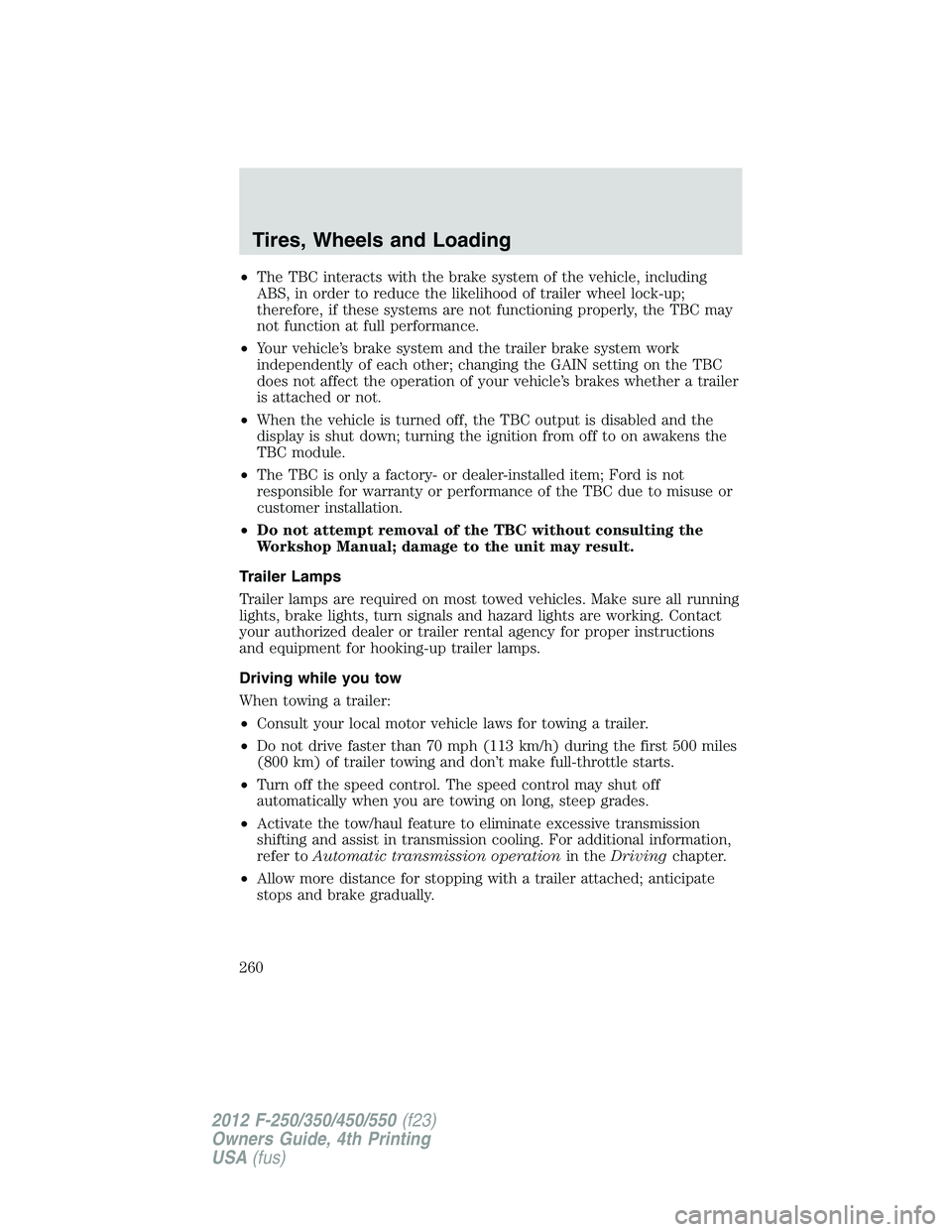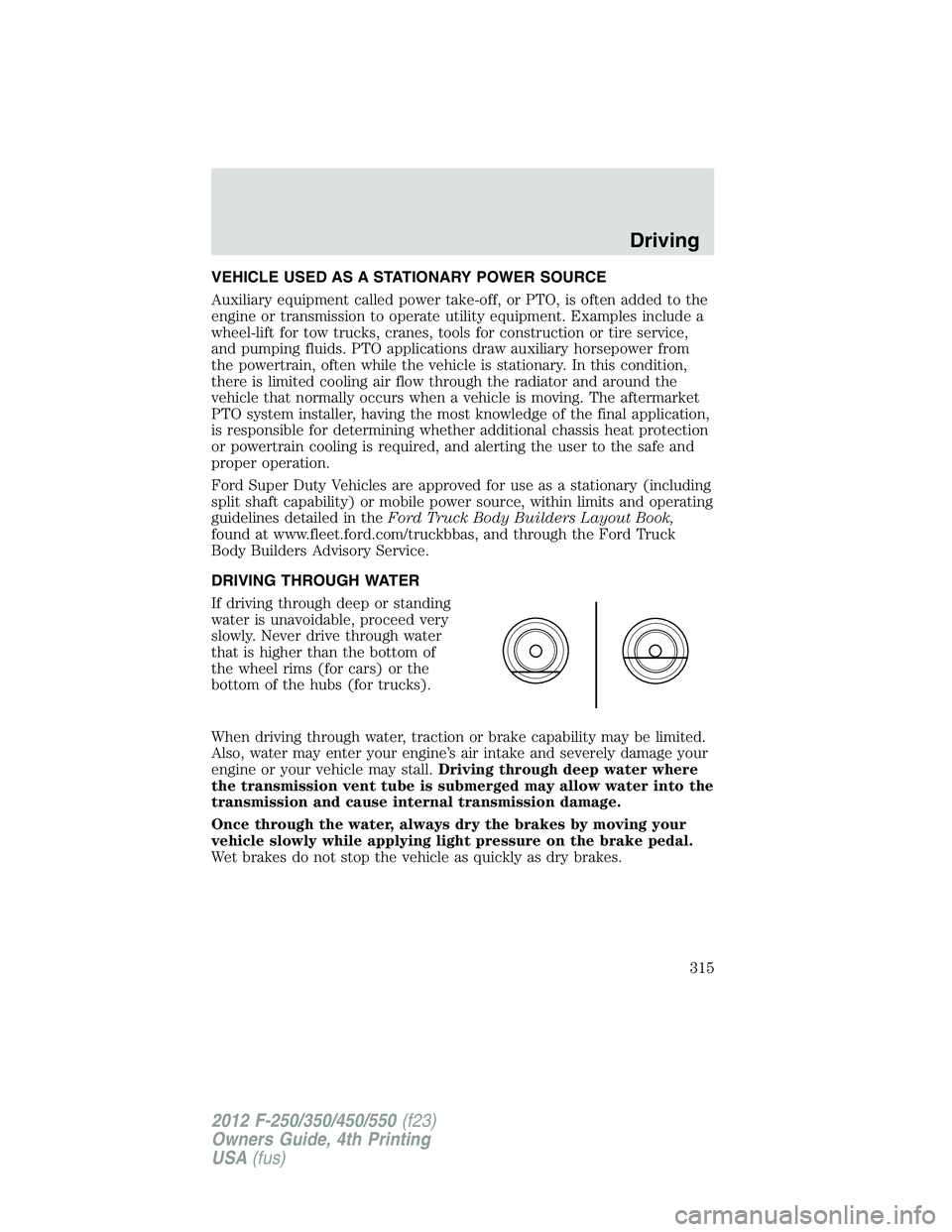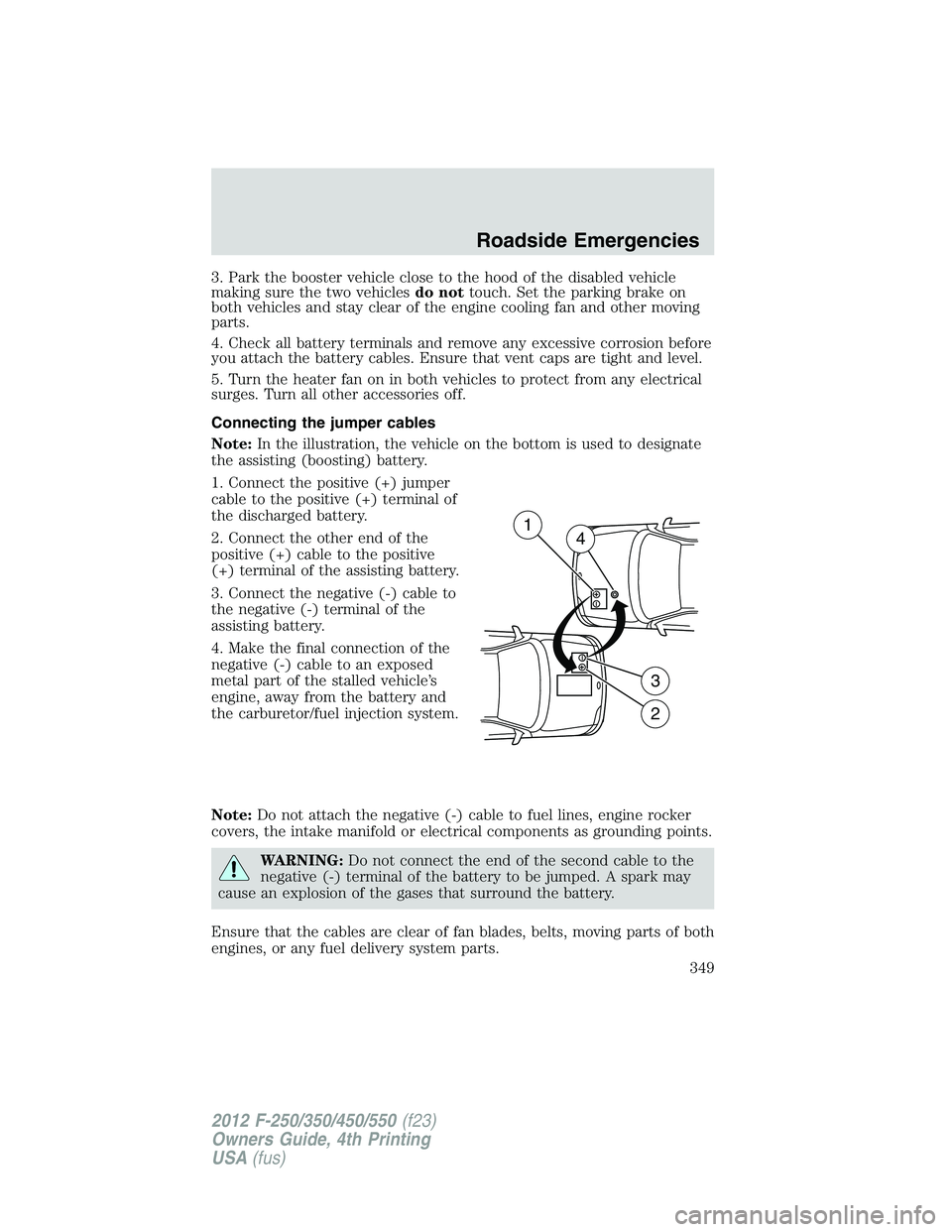2012 FORD F250 cooling
[x] Cancel search: coolingPage 260 of 448

•The TBC interacts with the brake system of the vehicle, including
ABS, in order to reduce the likelihood of trailer wheel lock-up;
therefore, if these systems are not functioning properly, the TBC may
not function at full performance.
•Your vehicle’s brake system and the trailer brake system work
independently of each other; changing the GAIN setting on the TBC
does not affect the operation of your vehicle’s brakes whether a trailer
is attached or not.
•When the vehicle is turned off, the TBC output is disabled and the
display is shut down; turning the ignition from off to on awakens the
TBC module.
•The TBC is only a factory- or dealer-installed item; Ford is not
responsible for warranty or performance of the TBC due to misuse or
customer installation.
•Do not attempt removal of the TBC without consulting the
Workshop Manual; damage to the unit may result.
Trailer Lamps
Trailer lamps are required on most towed vehicles. Make sure all running
lights, brake lights, turn signals and hazard lights are working. Contact
your authorized dealer or trailer rental agency for proper instructions
and equipment for hooking-up trailer lamps.
Driving while you tow
When towing a trailer:
•Consult your local motor vehicle laws for towing a trailer.
•Do not drive faster than 70 mph (113 km/h) during the first 500 miles
(800 km) of trailer towing and don’t make full-throttle starts.
•Turn off the speed control. The speed control may shut off
automatically when you are towing on long, steep grades.
•Activate the tow/haul feature to eliminate excessive transmission
shifting and assist in transmission cooling. For additional information,
refer toAutomatic transmission operationin theDrivingchapter.
•Allow more distance for stopping with a trailer attached; anticipate
stops and brake gradually.
Tires, Wheels and Loading
260
2012 F-250/350/450/550(f23)
Owners Guide, 4th Printing
USA(fus)
Page 281 of 448

Disabling trailer sway control
Trailer sway control can be disabled during any key cycle. See trailer
sway control under theMessage centerin theInstrument Cluster
chapter. Note that regardless of chosen enable state, trailer sway control
will be re-enabled at each new key cycle.
WARNING:Turning off trailer sway control increases the risk of
loss of vehicle control, serious injury, or death. Ford does not
recommend disabling this feature except in situations where speed
reduction may be detrimental (e.g., hill climbing), the driver has
significant trailer towing experience, and can control trailer sway and
maintain safe operation.
HILL DESCENT CONTROL (IF EQUIPPED)
Hill descent control allows the driver to set and maintain vehicle speed
while descending steep grades in various surface conditions.
WARNING:Hill descent control cannot control descent in all
surface conditions and circumstances, such as ice or extremely
steep grades. Hill descent control is a driver assist system and cannot
substitute for good judgment by the driver. Failure to do so may result
in loss of vehicle control, crash or serious injury.
Hill descent control can maintain vehicle speeds on downhill grades
between 2 mph (3 km/h) and 12 mph (20 km/h). Above 20 mph
(32 km/h), the system remains armed, but descent speed cannot be set
or maintained.
WARNING:Hill descent control does not provide hill hold at
zero mph (0 km/h). When stopped, the parking brake must be
applied and/or the vehicle must be placed in P (Park) or it may roll
away.
Hill descent control requires a cooling down interval after a period of
sustained use. The amount of time that the feature can remain active
before cooling varies with conditions. The system will provide a warning
in the message center and a chime will sound when the system is about
to disengage for cooling. At this time, manually apply the brakes as
needed to maintain descent speed.
Driving
281
2012 F-250/350/450/550(f23)
Owners Guide, 4th Printing
USA(fus)
Page 315 of 448

VEHICLE USED AS A STATIONARY POWER SOURCE
Auxiliary equipment called power take-off, or PTO, is often added to the
engine or transmission to operate utility equipment. Examples include a
wheel-lift for tow trucks, cranes, tools for construction or tire service,
and pumping fluids. PTO applications draw auxiliary horsepower from
the powertrain, often while the vehicle is stationary. In this condition,
there is limited cooling air flow through the radiator and around the
vehicle that normally occurs when a vehicle is moving. The aftermarket
PTO system installer, having the most knowledge of the final application,
is responsible for determining whether additional chassis heat protection
or powertrain cooling is required, and alerting the user to the safe and
proper operation.
Ford Super Duty Vehicles are approved for use as a stationary (including
split shaft capability) or mobile power source, within limits and operating
guidelines detailed in theFord Truck Body Builders Layout Book,
found at www.fleet.ford.com/truckbbas, and through the Ford Truck
Body Builders Advisory Service.
DRIVING THROUGH WATER
If driving through deep or standing
water is unavoidable, proceed very
slowly. Never drive through water
that is higher than the bottom of
the wheel rims (for cars) or the
bottom of the hubs (for trucks).
When driving through water, traction or brake capability may be limited.
Also, water may enter your engine’s air intake and severely damage your
engine or your vehicle may stall.Driving through deep water where
the transmission vent tube is submerged may allow water into the
transmission and cause internal transmission damage.
Once through the water, always dry the brakes by moving your
vehicle slowly while applying light pressure on the brake pedal.
Wet brakes do not stop the vehicle as quickly as dry brakes.
Driving
315
2012 F-250/350/450/550(f23)
Owners Guide, 4th Printing
USA(fus)
Page 349 of 448

3. Park the booster vehicle close to the hood of the disabled vehicle
making sure the two vehiclesdo nottouch. Set the parking brake on
both vehicles and stay clear of the engine cooling fan and other moving
parts.
4. Check all battery terminals and remove any excessive corrosion before
you attach the battery cables. Ensure that vent caps are tight and level.
5. Turn the heater fan on in both vehicles to protect from any electrical
surges. Turn all other accessories off.
Connecting the jumper cables
Note:In the illustration, the vehicle on the bottom is used to designate
the assisting (boosting) battery.
1. Connect the positive (+) jumper
cable to the positive (+) terminal of
the discharged battery.
2. Connect the other end of the
positive (+) cable to the positive
(+) terminal of the assisting battery.
3. Connect the negative (-) cable to
the negative (-) terminal of the
assisting battery.
4. Make the final connection of the
negative (-) cable to an exposed
metal part of the stalled vehicle’s
engine, away from the battery and
the carburetor/fuel injection system.
Note:Do not attach the negative (-) cable to fuel lines, engine rocker
covers, the intake manifold or electrical components as grounding points.
WARNING:Do not connect the end of the second cable to the
negative (-) terminal of the battery to be jumped. A spark may
cause an explosion of the gases that surround the battery.
Ensure that the cables are clear of fan blades, belts, moving parts of both
engines, or any fuel delivery system parts.
+–
+–
2
3
14
Roadside Emergencies
349
2012 F-250/350/450/550(f23)
Owners Guide, 4th Printing
USA(fus)
Page 380 of 448

Note:For best results, coolant concentration should be tested with a
refractometer such as Rotunda tool ROB75240 available from your
dealer. Ford does not recommend the use of hydrometers or coolant test
strips for measuring coolant concentrations.
Note:The engine coolant should be at the FULL COLD level, or between
the MIN and MAX marks, or within the COLD FILL RANGE, as listed on
the engine coolant reservoir (depending upon the application).
Note:Coolant expands when it is hot. The level may extend beyond the
FULL COLD level, or the MAX mark, or the COLD FILL RANGE.
If the level is below the FULL COLD level, at or below the MIN mark, or
below the COLD FILL RANGE, add coolant immediately per theAdding
engine coolantinstructions in this chapter.
Note:Automotive fluids are not interchangeable; do not use engine
coolant/antifreeze or windshield washer fluid outside of its specified
function and vehicle location.
Adding engine coolant
WARNING:Do not add engine coolant when the engine is hot.
Steam and scalding liquids released from a hot cooling system
can burn you badly. Also, you can be burned if you spill coolant on hot
engine parts.
WARNING:Do not put engine coolant in the windshield washer
fluid container. If sprayed on the windshield, engine coolant
could make it difficult to see through the windshield.
WARNING:To reduce the risk of personal injury, make sure the
engine is cool before unscrewing the coolant pressure relief cap.
The cooling system is under pressure; steam and hot liquid can come
out forcefully when the cap is loosened slightly.
WARNING:Do not add coolant further than the MAX mark.
Note:Do not use stop leak pellets, cooling system sealants, or unapproved
additives as they can cause damage to the engine cooling or heating
systems. This damage would not be covered under your vehicle’s warranty.
Maintenance and Specifications
380
2012 F-250/350/450/550(f23)
Owners Guide, 4th Printing
USA(fus)
Page 381 of 448

Note:During normal vehicle operation, the engine coolant may change
color from orange to pink or light red. As long as the engine coolant is
clear and uncontaminated, this color change does not indicate the engine
coolant has degraded nor does it require the engine coolant to be
drained, the system to be flushed, or the engine coolant to be replaced.
•DO NOT MIX different colors or types of coolant in your vehicle.
Mixing of engine coolants may harm your engine’s cooling system.
Only use engine coolant that meets the Ford specification. Generic
coolants for all makes and models may not meet the Ford
specification. The use of an improper coolant may harm engine and
cooling system components and may void the warranty. See
Capacities and Specificationsfor more information.
•In case of emergency, a large amount of water without engine coolant
may be added in order to reach a vehicle service location. In this
instance, the cooling system must be drained, chemically cleaned, and
refilled with prediluted engine coolant as soon as possible per the
instructions in the Workshop Manual. Water alone (without engine
coolant) can cause engine damage from corrosion, overheating or
freezing.
•Do not use alcohol, methanol, brine or any engine coolants mixed with
alcohol or methanol antifreeze (coolant). Alcohol and other liquids can
cause engine damage from overheating or freezing.
•
Do not add extra inhibitors or additives to the coolant. These can be
harmful and compromise the corrosion protection of the engine coolant.
For vehicles with overflow coolant systems and a non-pressurized
cap on the coolant recovery system,add prediluted engine coolant to
the FULL COLD level on the coolant recovery reservoir when the engine
is cool.
For vehicles with overflow coolant systems and a pressure relief
cap on the radiator,follow these steps to add engine coolant:
1. Turn off the engine and let it cool.
2. When the engine is cool, wrap a thick cloth around the coolant
pressure relief cap on the radiator.
3. Slowly turn the coolant pressure relief cap counterclockwise until
pressure begins to release.
4. Step back while the pressure releases.
5. When you are sure that all the pressure has been released, use the
cloth to turn it counterclockwise and remove the cap.
Maintenance and Specifications
381
2012 F-250/350/450/550(f23)
Owners Guide, 4th Printing
USA(fus)
Page 382 of 448

6. Remove the cap from the engine coolant reservoir.
7. Fill the coolant reservoir slowly with prediluted engine coolant to the
FULL COLD level, or between the MIN and MAX marks, or the COLD
FILL RANGE, as listed on the engine coolant reservoir (depending upon
application).
8. Add prediluted engine coolant to the radiator until the coolant is
visible and the radiator is almost full.
9. Install the cap to the engine coolant reservoir. Tighten the cap in
order to prevent coolant loss.
10. Install the pressure relief cap to the radiator. Tighten the cap in
order to prevent coolant loss.
For vehicles which have a coolant degas system with a
pressurized cap on the coolant reservoir,follow these steps to add
engine coolant:
1. Turn off the engine and let it cool.
2. When the engine is cool, wrap a thick cloth around the coolant
pressure relief cap on the coolant reservoir.
3. Slowly turn the coolant pressure relief cap counterclockwise until
pressure begins to release.
4. Step back while the pressure releases.
5. When you are sure that all the pressure has been released, use the
cloth to turn it counterclockwise and remove the cap.
6. Fill the coolant reservoir slowly with prediluted engine coolant to
within the FULL COLD level, or between the MIN and MAX marks, or
the COLD FILL RANGE, as listed on the engine coolant reservoir
(depending upon application).
Whenever you add coolant, check the coolant concentration. See
Checking the engine coolantin this chapter. If the concentration is not
50%, drain some coolant and adjust the concentration. It may take
several drains and additions to obtain a 50% coolant concentration.
The next few times you drive the vehicle, check the coolant level in the
coolant reservoir. If necessary, add enough prediluted engine coolant to
bring the coolant level to the proper level.
If you have to add more than 1.0 quart (1.0 liter) of engine coolant per
month, have your authorized dealer check the engine cooling system. Your
cooling system may have a leak. Operating an engine with a low level of
coolant can result in engine overheating and possible engine damage.
Maintenance and Specifications
382
2012 F-250/350/450/550(f23)
Owners Guide, 4th Printing
USA(fus)
Page 383 of 448

Recycled engine coolant
Ford Motor Company does not recommend the use of recycled engine
coolant since a Ford-approved recycling process is not yet available.
Always dispose of used automotive fluids in a responsible manner.
Follow your community’s regulations and standards for recycling and
disposing of automotive fluids.
Coolant refill capacity
To find out how much fluid your vehicle’s cooling system can hold, refer
toMaintenance product specifications and capacitiesin this chapter.
If your vehicle is equipped with a diesel engine,refer to the
Maintenance product specifications and capacitiessection of your
diesel supplement.
Fill your engine coolant reservoir as outlined previously in theAdding
engine coolantsection.
Severe climates
If you drive in extremely cold climates:
•It may be necessary to have a Ford authorized dealer increase the
coolant concentration above 50%.
•A coolant concentration of 60% will provide improved freeze point
protection. Engine coolant concentrations above 60% will decrease the
overheat protection characteristics of the engine coolant and may
cause engine damage.
If you drive in extremely hot climates:
•It may be necessary to have a Ford authorized dealer decrease the
coolant concentration to 40%.
•A coolant concentration of 40% will provide improved overheat
protection. Engine coolant concentrations below 40% will decrease the
corrosion/freeze protection characteristics of the engine coolant and
may cause engine damage.
Vehicles driven year-round in non-extreme climates should use
prediluted engine coolant for optimum cooling system and engine
protection.
Maintenance and Specifications
383
2012 F-250/350/450/550(f23)
Owners Guide, 4th Printing
USA(fus)